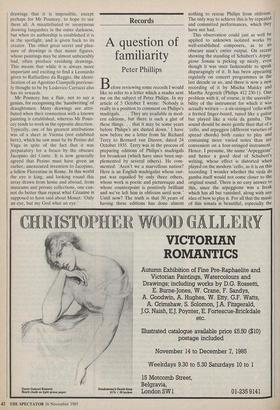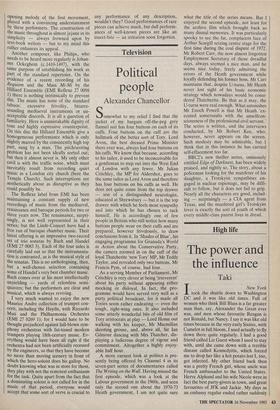Records
A question of familiarity
Peter Phillips
Before reviewing some records I would like to refer to a letter which a reader sent me on the subject of Peter Philips. In my article of 5 October I wrote: 'Nobody is really in a position to comment on Philips's madrigals. . . . They are available in mod- ern editions, but there is such a glut of these things. . . that it may be some years before Philips's are dusted down.' I have now before me a letter from Sir Richard Terry to Bernard van Dieren, dated 24 October 1935. Terry was in the process of preparing editions of Philips's madrigals for broadcast (which have since been sup- plemented by several others). He com- mented: 'Aren't we a marvellous nation? Here is an English madrigalist whose out- put was equalled by only three others, whose work is poetic and picturesque and whose counterpoint is positively brilliant and we've left him in oblivion until now.' Until now? The truth is that 50 ,years of having these editions has done almost
nothing to rescue Philips from oblivion. The only way to achieve this is by repeated and committed performances, which they have not had.
This observation could just as well be applied to unknown isolated works by well-established composers, as to an obscure man's entire output. On recent showing the standing of Schubert's Arpeg- gione Sonata is picking up nicely, even though it was once fashionable to speak disparagingly of it. It has been appearing regularly on concert programmes in the last decade or so, and there is now a new recording of it by Mischa Maisky and Martha Argerich (Philips 412 230-1). One problem with it, of course, is the unavaila- bility of the instrument for which it was actually written — a six-stringed 'cello with a fretted finger-board, tuned like a guitar but played like a viola da gamba. The sound should be more gentle than that of a 'cello, and arpeggios (different varieties of spread chords) both easier to play and containing more varied notes than are convenient on a four-stringed instrument. Hence, I presume, the name `Arpeggione' and hence a good deal of Schubert's writing, whose effect is distorted when played on the modern 'cello, as it is on this recording. I wonder whether the viola da gamba itself would not come closer to the original sound. There is no easy answer to this, since the arpeggione was a freak which has all but vanished, along with any idea of how to play it. For all that the music of this sonata is beautiful, especially the
opening melody of the first movement, played with a convincing understatement by these performers. The construction of the music throughout is almost jejune in its simplicity — always frowned upon by text-book writers — but to my mind this rather enhances its appeal.
Another composer, like Philips, who needs to be heard more regularly is Johan- nes Ockeghem (c.1410-1497), with the same purpose of establishing his work as part of the standard repertoire. On the evidence of a recent recording of his Requiem and the Mass Mi-Mi by the Hilliard Ensemble (EMI Reflexe 27 0098 1) there is nothing intrinsically to prevent this. The music has none of the standard taboos: excessive frivolity, bizarre- sounding mediaeval instruments or un- acceptable discords. It is all a question of familiarity. Here is unmistakable dignity of tone and highly expressive counterpoint. On this disc the Hilliard Ensemble give a homogeneous performance which is only slightly marred by the consistently high top part, sung by a man. The pitch/scoring problem has not been ideally sorted out; but then it almost never is. My only other cavil is with the traffic noise, which must inevitably result from recording quiet music in a London city church (here the Temple Church). Such interruptions are aesthetically about as disruptive as they could possibly be.
The Reflexe label from EMI has been maintaining a constant supply of new recordings of music from the mediaeval, renaissance and baroque periods for two or three years now. The renaissance, surpri- singly, is not well represented in their series; but the Linde-Consort have had a free run of baroque chamber music. Their latest offering is an impressive two-record set of trio sonatas by Bach and Handel (EMI 27 0083 3). Each of the four sides is carefully laid out so that the instrumenta- tion is contrasted, as is the musical style of the sonatas. This is no anthologising, then, but a well-chosen selection containing some of Handel's very best chamber music. Bach comes over at his most intellectually unyielding — yards of relentless semi- quavers; but the performers are clear and musical, which is always reviving.
I very much wanted to enjoy the new Maurice Andre collection of trumpet con- certi, including the Haydn, with Riccardo Muti and the Philharmonia Orchestra (EMI 27 0269 1); for I would hate to be thought prejudiced against full-blown sym- phony orchestras with fat-toned modern trumpets playing 18th-century music. Ev- erything would have been all right if the orchestra had not been artificially recessed by the engineers, so that they have become no more than moving scenery in front of which the hero-soloist does his gallop. No doubt knowing what was in store for them, they play with not the remotest enthusiasm for the task. Quite apart from the fact that a dominating soloist is not called for in the music of that period, everyone would accept that some sort of verve is crucial to any performance of any description, wouldn't they? Good performances of rare pieces can achieve much, but dull perform- ances of well-known pieces are like an insect-bite — an irritation soon forgotten.



































































 Previous page
Previous page